Are you dreaming of an exotic getaway? Morocco offers a captivating blend of culture, history, and stunning landscapes. Where To Travel In Morocco becomes an easy question to answer when you explore our expertly curated guide. At TRAVELS.EDU.VN, we provide you with the inside scoop on the most enchanting destinations, ensuring an unforgettable experience. Discover the magic of Moroccan travel with our assistance and turn your dream vacation into a reality. Let us take the stress out of planning with our exceptional service, offering you peace of mind and the best possible holiday experience. Uncover hidden gems, cultural richness, and awe-inspiring beauty with our tailored travel solutions. Get ready for an authentic experience, cultural immersion, and adventure with our exclusive Moroccan travel packages.
1. Do I Need a Visa to Travel to Morocco?
For short stays, generally no. Citizens of the United States, Canada, the United Kingdom, the European Union, Australia, New Zealand, and numerous other countries can visit Morocco for tourism purposes without a visa for up to 90 days. Be sure to check the latest requirements from your country’s embassy, as these things can change.
Morocco has lifted all COVID-19 related travel restrictions, making it easier than ever to explore this vibrant country.
2. Where is Morocco Located?
Morocco is in Northwest Africa. Its location just below Spain, across the Strait of Gibraltar, makes it a unique blend of African, Arab, Berber, and European influences.
2.1. How Can I Travel to Morocco?
Traveling to Morocco is easier than you might think. Here’s how:
-
By Air: The primary airport is Casablanca Airport (CMN), served by major airlines like Delta, American Airlines, Emirates, British Airways, and Air Canada. Marrakech Menara Airport (RAK) is another option. United Airlines, for example, flies into Casablanca but not Marrakech. Consider flying into one airport and out of the other, depending on your itinerary.
Caption: Fly into Casablanca Airport for a convenient start to your Moroccan journey.
-
By Ferry: From Spain, ferries take between 1.5 to 36 hours, depending on the route. Algeciras and Tarifa to Tangier are the fastest, at 60-90 minutes. Barcelona to Tangier takes about 28-36 hours. You can also bring your car on the ferry.
3. How Can I Get Around Morocco?
Once you arrive, here are the best ways to navigate Morocco:
- Trains: Morocco has a reliable and comfortable rail network connecting major northern cities at affordable prices.
- Buses: Public and private bus companies serve cities nationwide. However, buses can be slow and crowded.
- Taxis:
- Petit taxis: Small vehicles for up to three passengers, ideal for city travel.
- Grand taxis: Larger vehicles for up to six passengers, used for intercity travel.
- Ride-Sharing Apps: Uber is unavailable in Morocco, but Careem operates in major cities. In Marrakech, try Heetch or Roby. Hotels and Riads can also arrange private drivers.
- Planes: Domestic flights via Royal Air Maroc and Air Arabia Maroc connect major cities.
4. What Is The Best Time to Visit Morocco?
Spring and fall are ideal. Visit from March to May or September to November for pleasant weather and fewer tourists. June is also a good time to visit because the weather is lovely and it is not too crowded.
4.1. Planning Around Religious Holidays
Islam is the official religion in Morocco. Ramadan can affect your travel plans, lasting 30 days from March/April to April/May. During this time, Muslims fast from dawn to sunset, so many local restaurants and cafes are closed during the day. Some close for the entire month.
Experiencing Morocco during Ramadan can be unique. Celebrations fill the cities after sunset.
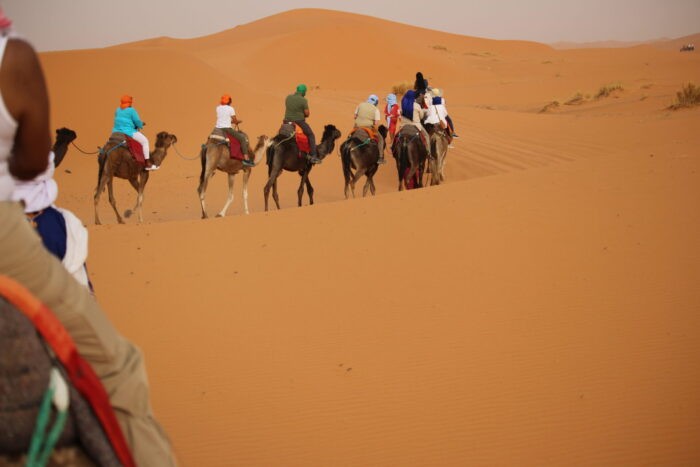 Camel ride in the Sahara Desert at Sunset
Camel ride in the Sahara Desert at Sunset
Caption: Enjoy a camel ride during the serene hours of sunset in the Sahara.
4.2. Seasons & Weather in Morocco
- Northern Cities (Casablanca, Tangier): Mediterranean climate with cooling sea breezes. Average summer temperature is 73 °F (23 °C), winter is 55 °F (13 °C).
- Central and Southern Morocco (Fes, Marrakech): Summers are hot, with Marrakech averaging in the 90s and sometimes reaching triple digits. Winter averages 54 °F (12 °C).
- Rainy Season: November to March, especially in coastal regions.
5. What Languages Are Spoken in Morocco?
Morocco has two official languages: Modern Standard Arabic and Standard Moroccan Berber. Moroccan Arabic and Berber dialects are more commonly spoken. French is also widely used due to Morocco’s colonial past.
5.1. Do People Speak English in Morocco?
English is not widely spoken. However, most people in the tourism sector have basic English skills.
6. What Currency Is Used in Morocco?
The Moroccan Dirham (MAD) is the currency. Many establishments prefer cash, so use ATMs to withdraw money. Credit cards are accepted in restaurants and main shops, but cash is useful for tipping and shopping in souks.
7. What Should I Wear in Morocco?
Dress modestly out of respect for local customs. Women should wear tops that cover the chest and shoulders, and lightweight pants or skirts that cover the knees. Shoulders, chest, and knees should be covered when visiting mosques. Head coverings are not always required, but bring a scarf just in case. Marrakech tends to be more casual. Shoes must be removed when entering mosques, so bring a bag for them.
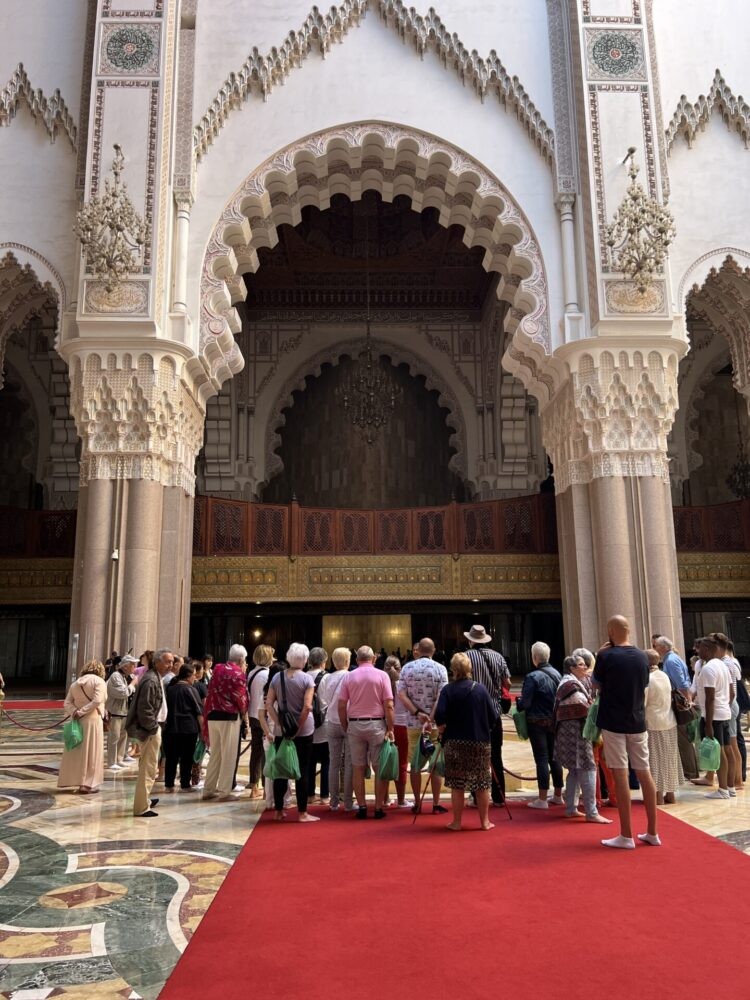 Bare feet inside Hassan II Mosque
Bare feet inside Hassan II Mosque
Caption: Remember to remove your shoes when entering the mosques in Morocco.
8. What Are Some Popular Places to Stay in Morocco?
Riads are popular accommodations in Moroccan cities. These traditional hotels or guesthouses feature shared common areas and gardens with private rooms, often in restored palaces and mansions. Many are located within the Medinas, offering convenient access to dining and shopping.
For quieter accommodations, consider hotels and resorts outside the Medina.
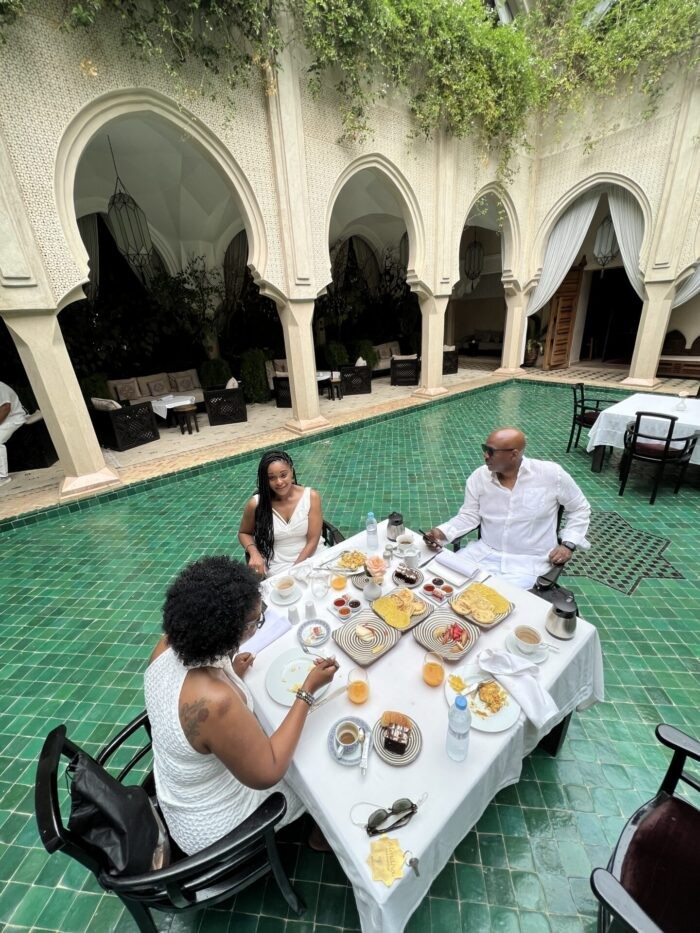 Riad Almaha in Morocco
Riad Almaha in Morocco
Caption: Enjoy the traditional elegance of a Riad during your stay in Morocco.
9. What Are The Best Places to Visit & Things to Do in Morocco?
Each Moroccan city has its own distinct charm. Here are our top recommendations:
9.1. Casablanca
Casablanca is a modern, bustling city with historic touches, and it feels like Morocco’s capital.
- Hassan II Mosque: One of the largest mosques in the world, open to non-Muslims.
- Mohamed V Square: A vibrant hub where locals gather.
- Museum of Moroccan Judaism: Showcases the 2,000-year history of the Jewish community in Morocco.
9.2. Fes
Fes is an ancient and historic city with narrow streets leading to lively Medinas and majestic mosques.
-
Royal Palace: Admire the stunning seven front gates.
-
Jewish Cemetery: An expansive cemetery established in 1883, featuring uniquely shaped white tombs.
-
Madrasa Bou Inania: A 14th-century Muslim learning institute with stunning architecture.
-
Borj Nord: A 16th-century fort housing the Museum of Arms.
-
Medina: One of the most expansive historic districts in the country, offering an authentic experience. Be cautious and keep belongings secure in this overwhelming market.
 The Medina in Fes
The Medina in FesCaption: Navigate the winding streets of the Medina in Fes for an authentic cultural experience.
-
Chouara Tanneries: Observe the dyeing of animal skins and hides. Be prepared for a strong smell, and consider using mint leaves to prevent nausea. Offers amazing leather goods and haggling opportunities.
 The gates to the Royal Palace in Fes
The gates to the Royal Palace in FesCaption: Marvel at the intricate craftsmanship of the Royal Palace gates in Fes.
9.3. Merzouga
Merzouga is a tranquil town in the Sahara Desert, acting as a gateway to Erg Chebbi.
-
Glamping in the Merzouga Desert: Experience a starlit sky free from light pollution. Enjoy camel rides, sandboarding, and live music around a fire.
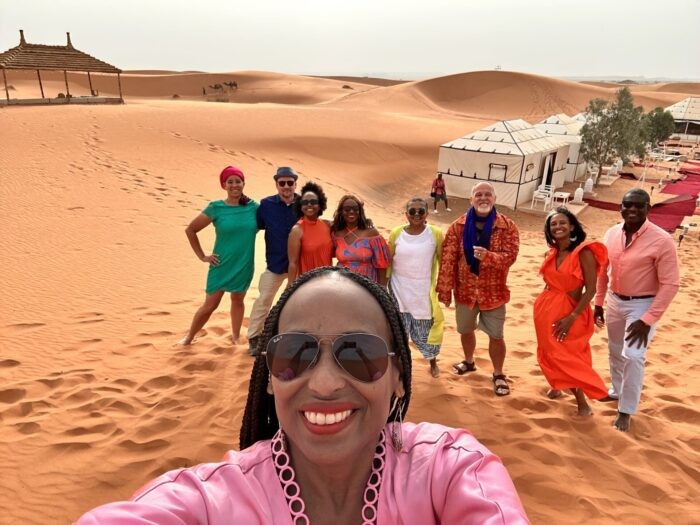 Glamping Site in Merzouga
Glamping Site in MerzougaCaption: Participate in a colorful photoshoot at your glamping site in The Sahara.
-
Hike to the Highest Dune in Erg Chebbi: Requires about an hour, so avoid midday and bring lots of water.
-
Dayet Srji: A salt lake west of Merzouga, attracting migratory birds like flamingos.
9.4. Dades Valley/Dades Gorge
The scenic Dades Valley is nestled in the rugged Atlas Mountains.
-
Boumalne Dades: The main city, located on a plateau and surrounded by cliffs.
-
Auberge Chez Pierre Hotel: A lovely hotel with modern comforts. Enjoy a 5-course meal for around 22 euros.
-
Explore the Dades Valley: From towering cliffs to fertile gardens, this varied paradise is home to warm and welcoming locals.
-
Rose Valley and Kelaat M’Gouna: Immerse yourself in Morocco’s Berber culture in this desert region.
 Exploring the wonders of Dades Gorge
Exploring the wonders of Dades GorgeCaption: Wander through the stunning landscapes of Dades Gorge.
9.5. Marrakech
Marrakech seamlessly blends tradition and modernity, considered the major city of Central Morocco.
-
Koutoubia Mosque: The largest mosque in Marrakech, also known as “Mosque of the Booksellers.” Its minaret is an important landmark.
-
Jemaa el-Fnaa: A bustling square with street performers, musicians, and food stalls.
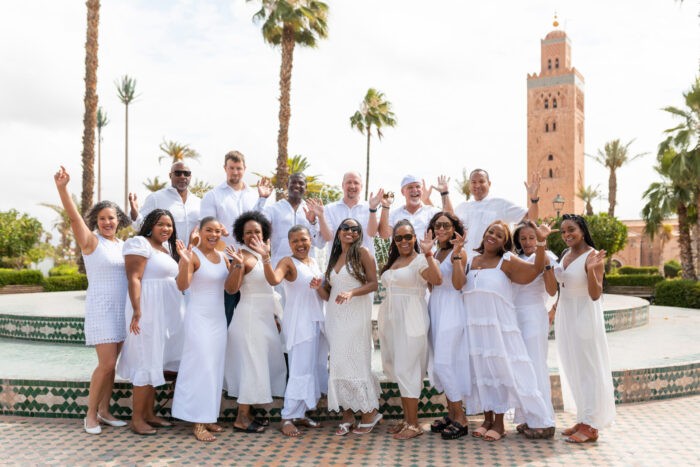 Group trip in Marrakech
Group trip in MarrakechCaption: Gather around with friends to explore the beauty of Marrakech.
-
Bahia Palace: An opulent palace with tranquil courtyards, lush gardens, and studded fountains.
-
Jardin Majorelle: A lush botanical garden with bamboo groves, dwarf palm trees, and the Berber Museum. The “Majorelle Blue” is a must-see.
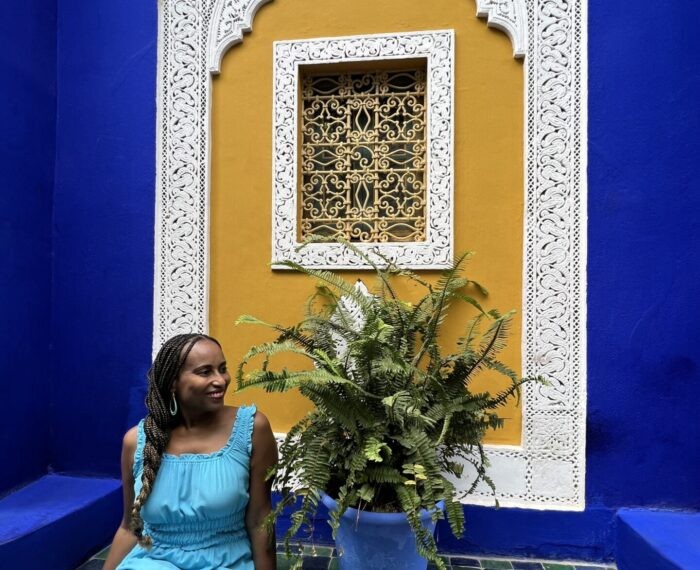 Woman posing at Majorelle Jardin in Marrakech
Woman posing at Majorelle Jardin in MarrakechCaption: Explore the iconic Majorelle Jardin, famous for its vibrant blue color.
-
YSL Museum: Features exhibits of Yves Saint Laurent’s work, including garments, accessories, sketches, and photos.
-
Hotel La Maison Arabe: Take a Tagine cooking class and enjoy a Hammam spa treatment.
-
Jnane Tamsna: A Black woman-owned hotel about 15 minutes from the Medina, perfect for cocktails and dinner at sunset.
 Enjoying the Moroccan sunset at Jnane Tamsna
Enjoying the Moroccan sunset at Jnane TamsnaCaption: Unwind and enjoy the breathtaking sunset at Jnane Tamsna.
Itinerary: A well-planned trip can cover a lot of ground, such as starting in Casablanca, spending two nights in Fes, one night glamping in the Sahara/Merzouga, one night in Dades/Atlas Mountains, and three nights in Marrakech. If time is limited, focus on one or two cities. Marrakech is a favorite.
10. What Traditional Foods & Beverages Should I Try in Morocco?
Moroccan cuisine is aromatic and full of spices like turmeric, saffron, and cumin.
-
Couscous: Morocco’s national dish, served with a stew of meat and/or vegetables.
-
Harira: A soup made from tomatoes, lentils, chickpeas, and lamb, traditionally served during Ramadan.
-
R’fissa: A Casablanca staple made with flaky pancakes, chicken in onion broth, herbs, and spices.
-
Tanjia: A traditional Marrakech dish of lamb or veal prepared in a terracotta jar.
-
Tagine: A dish cooked in a clay pot, with slow-cooked chunks of lamb, beef, or chicken with herbs and spices.
-
Pastilla: A savory meat pie with a poultry or seafood filling, including sugar, cinnamon, and almonds.
-
Zalouk: A spread made of eggplants, garlic, tomatoes, olive oil, and spices, served with crusty bread.
-
Gazelle Horns: Moroccan cookies made with an almond and orange blossom filling wrapped in thin pastry.
-
Chebakia: A dessert made of a honey-dipped fried sesame cookie in the shape of a flower.
-
Msemen: A flatbread eaten for breakfast and as street food, either sweet or savory.
-
Baghrir: Moroccan pancakes known as “thousand hole pancakes.”
-
Mint Tea: The most popular beverage in Morocco, made with fresh mint and sugar.
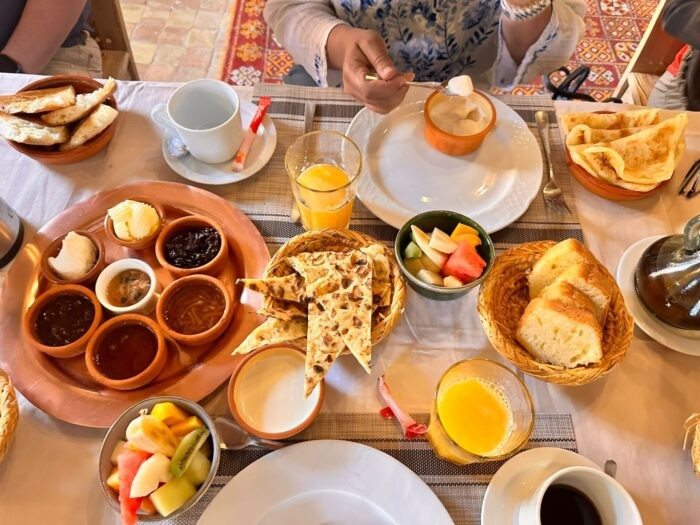 A typical Moroccan breakfast spread
A typical Moroccan breakfast spreadCaption: Start your day with a delightful traditional Moroccan breakfast.
-
 Preparing mint tea during a cooking class
Preparing mint tea during a cooking classCaption: Learn to make authentic Moroccan mint tea, a staple in the culture.
-
 Moroccan assortment of food
Moroccan assortment of foodCaption: Enjoy a delicious assortment of Moroccan cuisine, including beans and bread.
-
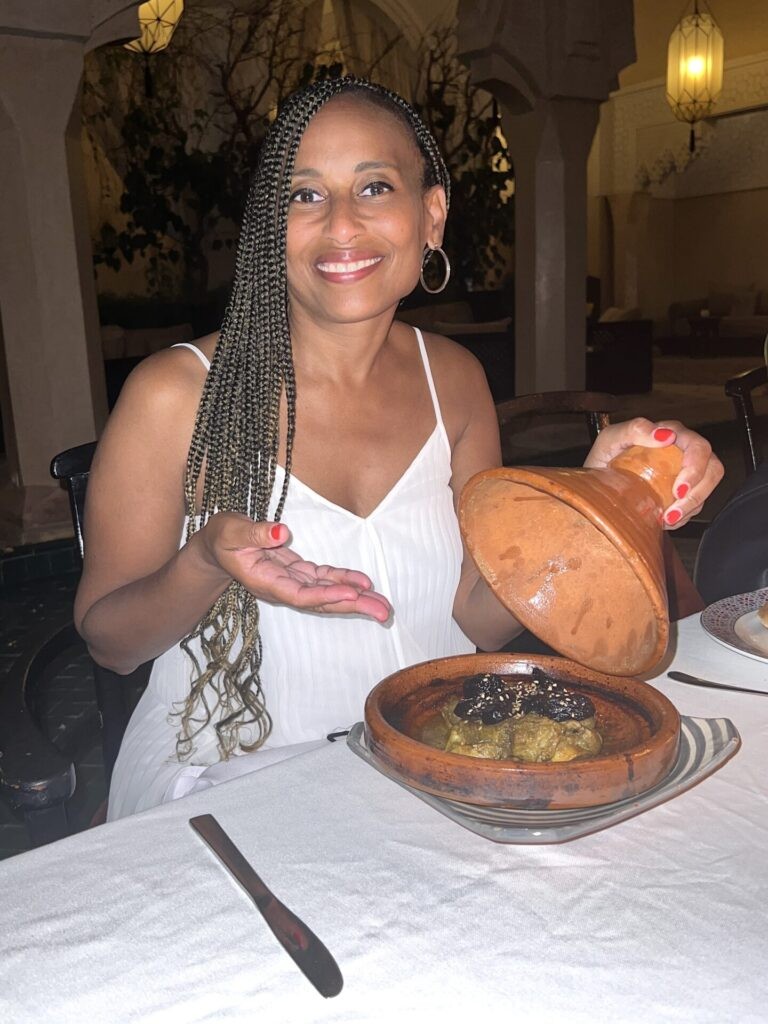 A beef Tagine with prunes
A beef Tagine with prunesCaption: Savor the unique flavors of a traditional beef Tagine with prunes.
11. What Are Some Good Souvenirs to Buy in Morocco?
Morocco offers amazing shopping opportunities. From wine and leather goods to home décor, pottery, furniture, jewelry, and clothing, be sure to budget for shopping.
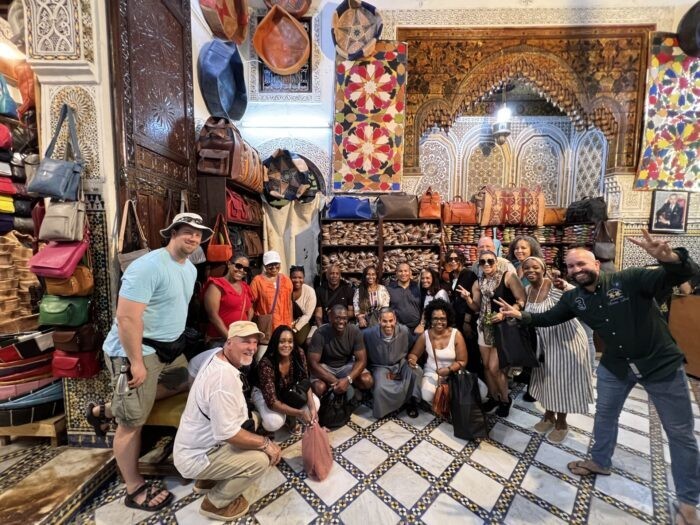 Group in a leather shop in Morocco
Group in a leather shop in Morocco
Caption: Explore the vibrant leather shops and find unique souvenirs to take home.
FAQ: Discovering Morocco
11.1. Is Morocco Safe for Tourists?
Yes, Morocco is generally safe for tourists. However, it’s always wise to take precautions against petty theft, especially in crowded areas like the medinas. Be aware of your surroundings and keep your belongings secure.
11.2. What is the best way to get around in Moroccan cities?
Taxis are a convenient option for getting around cities, with petit taxis for short distances and grand taxis for longer journeys. Alternatively, consider using ride-sharing apps like Careem, Heetch, or Roby where available.
11.3. Do I need to haggle when shopping in Morocco?
Haggling is a common practice in Moroccan markets and souks. Don’t be afraid to negotiate prices, but always do so respectfully and with a smile.
11.4. What is the appropriate way to dress in Morocco?
Morocco is a predominantly Muslim country, so it’s best to dress modestly, especially when visiting religious sites. Women should cover their shoulders, chest, and knees.
11.5. Can I drink alcohol in Morocco?
Alcohol is available in Morocco, particularly in hotels, restaurants, and bars that cater to tourists. However, it’s important to drink responsibly and respect local customs, especially during Ramadan.
11.6. What are some must-try Moroccan dishes?
Some must-try Moroccan dishes include couscous, tagine, pastilla, harira soup, and mint tea. Be sure to explore the local cuisine and try a variety of flavors and spices.
11.7. What is the best time of year to visit Morocco?
The best time to visit Morocco is during the spring (March to May) or fall (September to November) when the weather is mild and pleasant.
11.8. Are credit cards widely accepted in Morocco?
Credit cards are accepted in many hotels, restaurants, and larger shops, but it’s always a good idea to carry some cash, especially when shopping in markets or smaller establishments.
11.9. How can TRAVELS.EDU.VN enhance my trip to Morocco?
TRAVELS.EDU.VN provides expertly curated travel solutions, offering tailored itineraries, exclusive travel packages, and insider tips to ensure an unforgettable experience in Morocco.
11.10. What should I know about Ramadan in Morocco?
During Ramadan, many restaurants and cafes are closed during the day, and daily life may be affected. However, experiencing Morocco during Ramadan can be a unique cultural experience.
Planning a trip to Morocco can be an exciting adventure, and TRAVELS.EDU.VN is here to help you every step of the way. If you’re ready to book your Moroccan adventure or have any questions, contact us today!
Address: 123 Main St, Napa, CA 94559, United States
Whatsapp: +1 (707) 257-5400
Website: TRAVELS.EDU.VN
Don’t wait—let us help you create unforgettable memories in the enchanting land of Morocco. Get in touch with travels.edu.vn now to start planning your dream vacation.